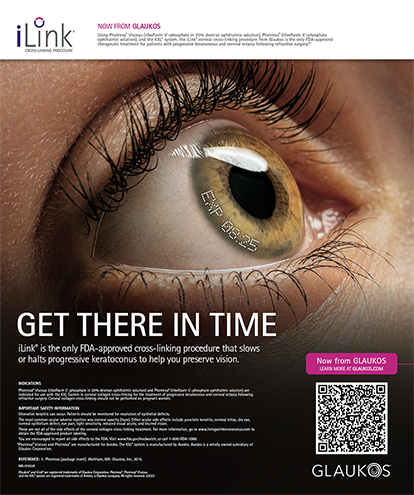Conductive keratoplasty (CK; Refractec, Inc., Irvine, CA) is the application of radiofrequency energy to the peripheral cornea to reshape its curvature. Using a combination of various spot patterns, CK is able to correct between 0.50 and 2.00 D of hyperopia, presbyopia, and astigmatism. The safety of CK is also to be noted.1 Because the procedure does not remove corneal tissue, it does not weaken the cornea structurally. A loss of BCVA did not occur in CK's FDA clinical trials, and, if the complication has ever occurred since then, it is tremendously rare.1 Furthermore, because CK does not sever corneal nerve fibers, dry eye is not a complication.
CK can be titrated. In the case of an undercorrection, the surgeon can place additional spots at a later time. Because the procedure is so quick and easy to perform, it is best to start conservatively with few spots and a large optical zone (7 to 8 mm). Depending on the outcome, enhancements may involve placing more spots in the same or next smaller zone for a greater effect.
Nearly one third of patients undergoing cataract surgery have more than 1.00 D of astigmatism. Given that most surgeons actually worsen or induce astigmatism unless they perform on-axis incisions, about half of these operated eyes have more than 1.00 D of astigmatism postoperatively—a degree of cylinder that is incompatible with 20/20 vision. Only 1.00 D of residual astigmatism will reduce UCVA to 20/30, although 1.50 D of residual astigmatism reduces it to 20/50. There is no effect on spherical equivalent. Surgeons should continue to aim for emmetropia with lens calculations as they would with astigmatic keratotomy.
In the current era of refractive cataract surgery, especially with the new technology presbyopia-correcting IOLs, our postoperative refractive goal should be 0.50 D or less of cylinder. Performing CK for astigmatism at the time of cataract surgery is a simple and effective method of achieving such results.
MY EXPERIENCE
Currently, I use CK to treat eyes with more than 1.25 D but less than 3.25 D of astigmatism. In an ongoing study, my colleague and partner, Richard L. Lindstrom, MD, and I have treated nine eyes. The median age of patients was 63 years. Our results are presented in Table 1. There have been no complications, no induction of astigmatism, and no loss of BCVA. Follow-up examinations are ongoing, and we have performed additional procedures.
TECHNICAL PEARLS
I prefer to perform CK for astigmatism prior to making any incisions for the cataract surgery. I apply an anesthetic of topical proparacaine to the cornea and then administer a povidone-iodine swab of the eyelids. I then place the Viewpoint lid speculum (Refractec, Inc.) on the eye. Next, I mark the cornea under the operating microscope; I use an RK marker to indicate the flat axis (Figure 1) and a CK marker to denote the 6-, 7-, and 8-mm optical zones (Figure 2). Using moderate-to-light pressure of the CK probe, I place one spot on either side of the flat meridian (minus cylinder axis) at the 8-mm optical zone for a total of two spots.
The CK for astigmatism procedure takes only 3 minutes. Afterward, the speculum is removed, and the patient is prepped and draped with a standard sterile technique. I reglove and proceed with cataract surgery.
CONCLUSION
Dr. Lindstrom and I estimate that 90 of astigmatic treatments during and after cataract surgery could be achieved with CK alone. If a greater effect than can be achieved with CK were needed, astigmatic keratotomy or excimer laser correction could be performed. In my opinion, CK for astigmatism is an ideal solution for the refractive cataract surgeon who wants to offer patients greater spectacle independence. It is safe, easy to perform, quick, and effective.
Elizabeth A. Davis, MD, is a partner at Minnesota Eye Consultants in Bloomington, and she is Adjunct Assistant Clinical Professor of Ophthalmology at the University of Minnesota, in Minneapolis. She acknowledged no financial interest in the products or company mentioned herein. Dr. Davis may be reached at (952) 885-2474; eadavis@mneye.com.


